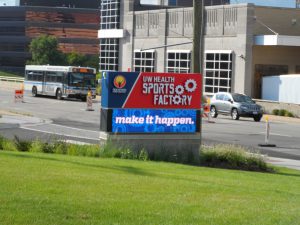Every year at ISA International Sign Expo, I get to meet with member companies either on the show floor or at the Sign Code Help Desk. The talk inevitably turns to sign code issues that they are facing—and it’s always interesting to see the commonalities.
No matter the size of the town or the geographic location, a few trends tend to emerge. At ISA International Sign Expo 2019, I collected a list of some of the most common questions asked—and have provided their answers here.
Question: A community where I do business wants to mandate sign lighting levels. What should I tell them?
First they need to realize how important effective night-time sign illumination is to their community’s businesses. There is research available that confirms this common-sense notion. It’s also true that drivers use illuminated signs to find their way safely at night, so communities do not want to mandate sign lighting restrictions that could negatively affect driver safety.
When it comes to traditional, internally illuminated signs, there are too many variables at play that should prevent local officials from imposing lighting restrictions. Even lighting curfews have drawbacks, as it has been proven that lighted signs—even when a business is closed—is a powerful marketing tool.
When it comes to digital signs, there are reasonable opportunities to work together. ISA’s Night-time Brightness Recommendations for On-Premise Electronic Message Centers has been implemented by hundreds of communities throughout the U.S. The publication—available at www.signs.org/emcs—also includes case studies of how communities have benefited from adopting reasonable lighting levels and provides guidance on measuring brightness levels in the safest, most accurate ways possible.

Question: My city severely restricts digital signs because they think they’re “dangerously distracting” to drivers. How do I overcome this argument?
Research is the best argument and the sign, graphics, and visual communications industry has valid evidence that this argument is simply untrue. Research conducted by Texas A&M University used over 130 locations in four states and years of traffic safety data to find no statistical correlation between traffic accidents and digital signs. Find it at www.signs.org/local.
Question: The sign I was trying to get permitted for my customer was denied by the zoning board of adjustments. What can I do now?
The first thing is to find out specifically why the sign was denied. Was there an error in the application? If so, correct it. Did the board deny the sign even though it is legally permissible according to code? Cite the code and ask for clarification.
If neither of those are the case, appeal. Be prepared to cite a reason and be sure to include how your sign will enhance the surrounding community as well. Detail how the property improvements can help revitalize the area, or increase incomes or property value, which leads to increased tax revenues. Enhanced readability will contribute to road safety.
The International Sign Association and Affiliated Association members can contact ISA’s sign code experts for advice on how to achieve successful outcomes for these individual cases.
If you have difficulties getting signs approved, consider making planners and local officials aware of the economic benefits of signs and how other communities have successfully developed reasonable sign codes. The best resources come from the Sign Research Foundation (www.signresearch.org), which has two studies that show the economic benefits of signs. An easy-to-use executive summary details the key points.
Question: It seems like we’re butting heads with local officials all the time. Isn’t there anything we can agree on?
We’ve found a lot of success through educating local officials. ISA has gathered some of the most persuasive research and reports at www.signs.org/local. Make your local officials aware of these resources.
ISA’s Planning for Sign Code Success™ events, Webinars, and other education is aimed specifically at planners. The more they learn about the benefits of sign codes and the technology, the more likely they are to at least understand what you’re trying to do—and why.
Bringing a mindset of collaboration rather than confrontation will work better every time. Reasonable sign codes benefit communities through a strong business environment, jobs and a solid tax base. That’s something we all can agree on.
Question: How can I better track sign codes to make sure that I can get my customers the signs they’re looking for?
Each community does things a little differently, so it’s important to learn how your community makes the public aware of these events. Is it through legal ads in the local newspaper? Make it a point to check them frequently. Do they publish on the town’s Web site? Set up an alert. Connect with local planners and the board of adjustments so that when your community is considering sign code changes they think of you first. It’s an often-thankless job but getting involved on sign code committees can benefit your company for years to come.
Also, connect with your ISA Affiliated Association (www.signs.org/affiliates). They may hear of sign code changes that are proposed.
For ongoing sign codes, it may not be fun trying to decipher complex and often confusing or contradictory languages. But many communities are working to make their sign codes more user friendly. Get involved—and bring ISA in! Because we work with communities throughout the country, we see commonalities—and solutions.
—David Hickey
David Hickey is Vice President of Government Affairs with the International Sign Association. If you have a sign code question or need help solving any of the aforementioned problems, email [email protected].











